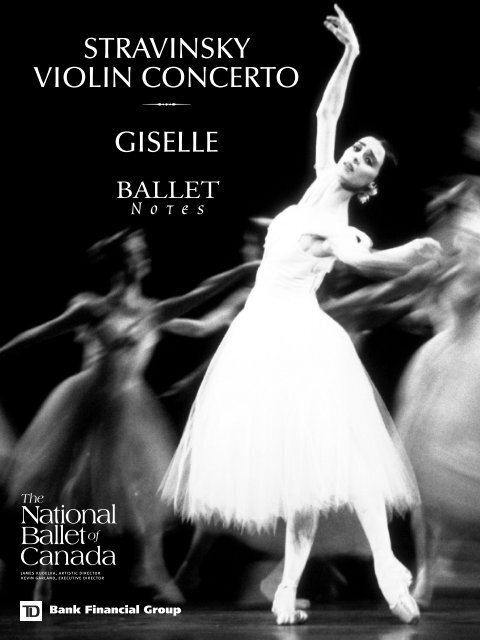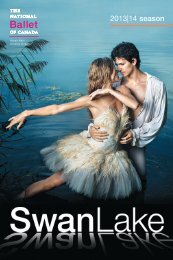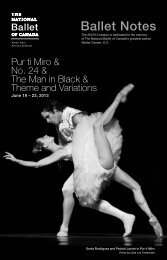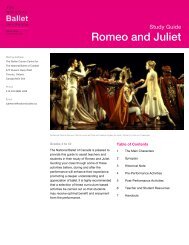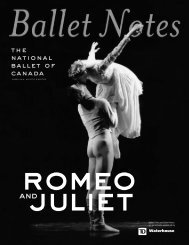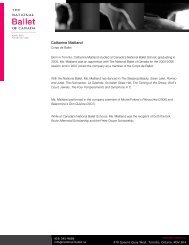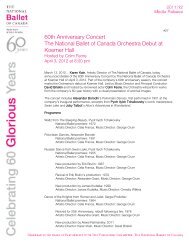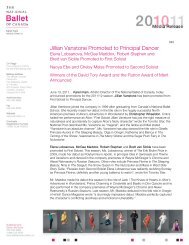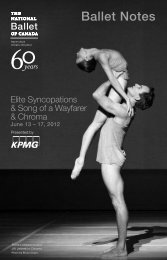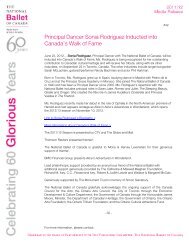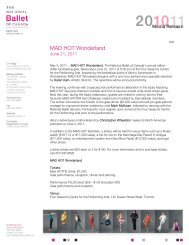stravinsky violin concerto giselle - The National Ballet of Canada
stravinsky violin concerto giselle - The National Ballet of Canada
stravinsky violin concerto giselle - The National Ballet of Canada
You also want an ePaper? Increase the reach of your titles
YUMPU automatically turns print PDFs into web optimized ePapers that Google loves.
STRAVINSKY<br />
VIOLIN CONCERTO<br />
<br />
GISELLE<br />
BALLET<br />
Notes
STRAVINSKY VIOLIN<br />
CONCERTO<br />
Choreography: George Balanchine<br />
Music: Igor Stravinsky, Concerto for Violin and Orchestra in D Major (1931)<br />
lighting design: christopher dennis<br />
Used by arrangement with European American Music Distributors Corporation LLC, sole<br />
Canadian and U.S. agent for Schott Musik International, publisher and copyright owner.<br />
Stravinsky Violin Concerto<br />
is presented by Walter Carsen, O.C.<br />
<strong>The</strong> performance <strong>of</strong> Stravinsky Violin Concerto, a Balanchine® <strong>Ballet</strong>, is presented by arrangement<br />
with <strong>The</strong> George Balanchine Trust sm and has been produced in accordance with the Balanchine<br />
Style®‚ and Balanchine Technique®‚ Service standards established and provided by the Trust.<br />
GISELLE<br />
Choreography and Production: Peter Wright<br />
after the choreography <strong>of</strong> Jean Coralli,<br />
Jules Perrot and Marius Petipa.<br />
based on the book by: Vernoy de Saint-Georges,<br />
Théophile Gautier and Jean Coralli<br />
Music: Adolphe Adam, revised by Joseph Horovitz<br />
Set and Costume Design: Desmond Heeley<br />
Lighting Design: Gil Wechsler<br />
Giselle was produced as a memorial to the late William<br />
P. Walker and was made possible through the courtesy<br />
<strong>of</strong> many generous friends <strong>of</strong> the <strong>National</strong> <strong>Ballet</strong>.<br />
BALLET<br />
Notes<br />
COVER: GRETA HODGKINSON WITH ARTISTS OF THE BALLET IN GISELLE. PHOTOGRAPHER: CYLLA VON TIEDEMANN<br />
ABOVE: CHAN HON GOH IN GISELLE. PHOTOGRAPHER: ANDREW OXENHAM
A NOTE ON STRAVINSKY<br />
VIOLIN CONCERTO<br />
<strong>The</strong> longstanding collaboration between choreographer<br />
George Balanchine and composer Igor Stravinsky resulted<br />
in many incomparable ballets - among the finest was<br />
Stravinsky Violin Concerto. New York City <strong>Ballet</strong> premiered<br />
this ballet under the title Violin Concerto on June<br />
18, 1972 by as part <strong>of</strong> the Stravinsky Festival at New York<br />
State <strong>The</strong>ater, starring Karin von Aroldingen, Kay Mazzo,<br />
Jean-Pierre Bonnefous and Peter Martins among the cast<br />
<strong>of</strong> twenty. <strong>The</strong> ballet became known as Stravinsky Violin<br />
Concerto in 1973.<br />
With its astringent and witty double pas de deux at the<br />
centre, Stravinsky Violin Concerto has a sense <strong>of</strong> play as<br />
well as an undercurrent <strong>of</strong> sexiness. In Stravinsky's vibrant<br />
and emotionally suggestive composition Balanchine had<br />
the perfect platform for his stylist experiments.<br />
BALANCHINE’S STYLE<br />
To fully appreciate Stravinsky Violin Concerto, it is best to<br />
begin with some information about the great choreographer,<br />
George Balanchine. Balanchine, co-founder and<br />
director <strong>of</strong> New York City <strong>Ballet</strong> until his death in 1983, is<br />
one <strong>of</strong> the most renowned and prolific choreographers <strong>of</strong><br />
the 20th century. Balanchine created a new genre <strong>of</strong> classical<br />
ballet that is synonymous today with New York City<br />
<strong>Ballet</strong>. Though that company is without doubt the greatest<br />
repository <strong>of</strong> Balanchine’s works, his ballets are also in the<br />
repertoires <strong>of</strong> more companies than any other choreographer’s.<br />
Balanchine’s ballets not only add diversity to a<br />
company’s repertoire, but also challenge dancers to a new<br />
level <strong>of</strong> technical brilliance.<br />
Balanchine was born in St. Petersburg, Russia, and<br />
received his dance training at the Imperial <strong>Ballet</strong> School.<br />
Nurtured in the ballet traditions <strong>of</strong> the turn <strong>of</strong> the century,<br />
particularly the ballets and pedagogy <strong>of</strong> the Russian ballet<br />
master Marius Petipa, Balanchine received a classic education.<br />
After leaving Russia in 1924, Balanchine became<br />
exposed to the work <strong>of</strong> Serge Diaghilev’s <strong>Ballet</strong>s Russes,<br />
and in turn created works for Diaghilev’s company. <strong>The</strong><br />
artistic milieu <strong>of</strong> the <strong>Ballet</strong>s Russes was highly stimulating,<br />
as Diaghilev brought his choreographers into<br />
collaboration with the composers Igor Stravinsky, Sergei<br />
Prok<strong>of</strong>iev, Erik Satie and Maurice Ravel and such visual<br />
artists as Pablo Picasso, Jean Cocteau and Marc Chagall.<br />
In 1933, with his own company, Les <strong>Ballet</strong>s, Balanchine<br />
collaborated with such leading artistic figures as Bertolt<br />
Brecht, Kurt Weill, Pavel Tchelitchev and composers<br />
Darius Milhaud and Henri Sauget.<br />
In 1933, at the invitation <strong>of</strong> Lincoln Kirstein, Balanchine<br />
travelled to the United States, where he and Kirstein<br />
established the School <strong>of</strong> American <strong>Ballet</strong> in 1934 and New<br />
York City <strong>Ballet</strong> in 1948. Through the creation <strong>of</strong> these two<br />
institutions, Balanchine was able to create <strong>of</strong> very distinct<br />
style <strong>of</strong> American dance. Writes dance critic Marilyn Hunt:<br />
“When Balanchine first came to the United States, he<br />
devised a way for Americans to appear on stage without<br />
feeling weighed down by traditions <strong>of</strong> court and ballet that<br />
they weren’t born to.”<br />
Balanchine’s style has been described as neoclassic, a<br />
reaction to the Romantic anti-classicism (which had<br />
turned into exaggerated theatricality) that was the prevailing<br />
style in Russian and European ballet when he had<br />
begun to dance. <strong>The</strong> beauty <strong>of</strong> Balanchine’s dances is to<br />
be found in their patterning, structure and in their relationship<br />
to the music. Balanchine was the creator <strong>of</strong><br />
abstract, one-act ballets. But for a handful, most <strong>of</strong> his<br />
works are non-narrative, the music and the dance conveying<br />
all necessary meaning. Some <strong>of</strong> Balanchine’s ballets<br />
pay homage to his Russian heritage, including <strong>Ballet</strong><br />
Imperial (1941) and the Diamonds section <strong>of</strong> the three-act,<br />
work Jewels (1967). While others proved provocative (<strong>The</strong><br />
Four Temperaments in 1946 and Agon in 1957), romantic<br />
(Serenade in 1934) and spectacular audience pleasers<br />
(Stars and Stripes in 1958, Union Jack in 1976 and Vienna<br />
Waltzes in 1977), all were achieved within his extended<br />
framework <strong>of</strong> classical ballet.<br />
“Dance can be enjoyed and understood without any verbal<br />
introduction or explanation,” Balanchine said. “<strong>The</strong> important<br />
thing in ballet is the movement itself, as it is sound<br />
which is important in a symphony. A ballet may contain a<br />
story, but the visual spectacle, not the story, is the essential<br />
element.”<br />
GEORGE BALANCHINE WITH IGOR STRAVINSKY IN REHEARSAL, CA. 1957. PHOTO BY MARTHA SWOPE.
Balanchine’s use <strong>of</strong> movement seems organically linked<br />
with the music and the dancers’ bodies. His work is<br />
always inventive and nothing superfluous is ever<br />
included. It is as if no other step than the one choreographed<br />
could possibly work within the structure <strong>of</strong> the<br />
piece.<br />
Balanchine created a distinctive vocabulary and style <strong>of</strong><br />
movement that closely reflects the structure <strong>of</strong> the music<br />
he used. Commenting on Balanchine’s use <strong>of</strong> music,<br />
dance critic Kenneth LaFave has noted: “Balanchine has<br />
explored the interactions <strong>of</strong> music and dance with almost<br />
every ballet, and has approached their combination<br />
afresh countless times. Look at his ballets superficially<br />
and they may seem to be illustrations <strong>of</strong> the music. Look<br />
at them closely and they appear as they really are: works<br />
that dance in the music, not merely to the beat.”<br />
Watching a Balanchine ballet is like watching and hearing<br />
a beautifully phrased conversation between dance<br />
and music. <strong>The</strong> most exciting moment <strong>of</strong> a Balanchine<br />
ballet is when you begin to “see the music and hear the<br />
A NOTE ON GISELLE<br />
One <strong>of</strong> the greatest and most revered choreographic<br />
accomplishments <strong>of</strong> the Romantic era <strong>of</strong> ballet, Giselle has<br />
enthralled audiences for generations and provided a<br />
wealth <strong>of</strong> dramatic and technical challenges for many <strong>of</strong><br />
the world’s greatest ballerinas, for whom the title role is<br />
one <strong>of</strong> the most demanding and fulfilling in the canon.<br />
Giselle received its premiere at the Paris Opera on June<br />
28, 1841. <strong>The</strong> title role <strong>of</strong> Giselle was performed by the<br />
famous Romantic ballerina Carlotta Grisi, who that<br />
evening celebrated her 22nd birthday. Lucien Petipa<br />
(brother <strong>of</strong> the choreographer Marius) performed the role<br />
<strong>of</strong> Albrecht. <strong>The</strong> ballet proved an instant success, and was<br />
quite spectacular, with the Duke and Albrecht’s fiancée,<br />
Bathilde, arriving at the village stage setting on horseback.<br />
<strong>The</strong> original scenario was conceived by Jules Henri<br />
Vernoy de Saint-Georges, a prolific librettist <strong>of</strong> the period,<br />
and Théophile Gautier, a noted critic and poet. <strong>The</strong> choreography<br />
was attributed to the Paris Opéra’s chief ballet<br />
master, Jean Coralli, though dances for the leading role <strong>of</strong><br />
Giselle have since been accredited to the choreographer<br />
Jules Perrot, who was Carlotta Grisi’s lover. <strong>The</strong> music<br />
dancing.” Balanchine’s relationship with music<br />
stemmed from his early childhood, when his musical<br />
studies were as important as his dance training. His<br />
understanding <strong>of</strong> musical theory, composition and playing<br />
enabled him to develop intimate working<br />
relationships with his composers. <strong>The</strong> <strong>National</strong> <strong>Ballet</strong> <strong>of</strong><br />
<strong>Canada</strong>’s late Artistic Director, Erik Bruhn, once noted:<br />
“He unravelled the intricate structure and emotional<br />
texture <strong>of</strong> music. Using the music <strong>of</strong> Bach, Mozart,<br />
Tchaikovsky, and, <strong>of</strong> course, his close friend Igor<br />
Stravinsky, Balanchine actually made ballet more aware<br />
<strong>of</strong> its musical potential.”<br />
Balanchine’s understanding <strong>of</strong> music allowed him to<br />
reach into the inner life <strong>of</strong> the music. It is not the obvious<br />
beat but the harmony in the music that motivates<br />
the dance. Said Balanchine <strong>of</strong> his use <strong>of</strong> music previously<br />
untouched by ballet choreographers: “If the dance<br />
designer sees in the development <strong>of</strong> classical dancing a<br />
counterpart in the development <strong>of</strong> music and has studied<br />
them both, he will derive continual inspiration from<br />
great scores.”<br />
was specially composed for the ballet by Adolphe Adam.<br />
Following its Paris premiere, Giselle was performed<br />
throughout Europe and the United States and also<br />
inspired a number <strong>of</strong> theatrical productions.<br />
<strong>The</strong> <strong>National</strong> <strong>Ballet</strong> <strong>of</strong> <strong>Canada</strong> has had Giselle in its repertoire<br />
since the company was founded in 1951. At the<br />
company’s very first performance on November 12, 1951,<br />
Lois Smith and David Adams performed the Peasant Pas<br />
De Deux from Act I <strong>of</strong> Giselle. During the 1969/70 <strong>National</strong><br />
<strong>Ballet</strong> season, Peter Wright was invited by Celia Franca to<br />
mount a new version <strong>of</strong> Giselle for the company. This new<br />
production premiered on April 16, 1970 at Toronto’s<br />
O’Keefe Centre (now renamed the Hummingbird Centre)<br />
starring guest artists Lynn Seymour and Egon Madsen.<br />
This highly praised production, with beautiful costumes<br />
and scenery by famed designer Desmond Heeley, has<br />
remained in the <strong>National</strong> <strong>Ballet</strong>’s active repertoire and has<br />
been performed across <strong>Canada</strong> and around the world. In<br />
1975, Giselle was filmed by director Norman Campbell for<br />
the Canadian Broadcasting Corporation. <strong>The</strong> programme<br />
featured Karen Kain and Frank Augustyn in the roles <strong>of</strong><br />
Giselle and Albrecht.<br />
FROM LEFT: ALEKSANDAR ANTONIJEVIC. PHOTOGRAPHER: CYLLA VON TIEDEMANN, SONIA RODRIGUEZ IN GISELLE. PHOTOGRAPHER: CYLLA VON TIEDEMANN,<br />
CHAN HON GOH IN GISELLE. PHOTOGRAPHER: ANDREW OXENHAM, ARTISTS OF THE BALLET IN GISELLE. PHOTOGRAPHER: CYLLA VON TIEDEMANN,
GISELLE SYNOPSIS<br />
Act I<br />
<strong>The</strong> first act is set in a Rhineland valley surrounded by<br />
vine-clad hills in medieval Germany. A majestic castle<br />
looms in the distance over the valley. It is autumn and the<br />
peasants are enjoying a rich harvest. Among the many<br />
happy festivities is the crowning <strong>of</strong> the Queen <strong>of</strong> the<br />
Vintage.<br />
Giselle is a young peasant girl who lives with her mother,<br />
Berthe. <strong>The</strong>ir cottage is opposite one that has recently<br />
been occupied by the handsome but mysterious Loys, a<br />
peasant farmer. Loys is really Count Albrecht <strong>of</strong> Silesia,<br />
who has disguised himself as a peasant in<br />
order to win Giselle’s affections. Giselle<br />
has fallen in love with Loys, but the<br />
local forester Hilarion loves Giselle and<br />
has always planned to marry her. Hilarion<br />
is suspicious <strong>of</strong> Loys and thinks he is hiding<br />
some secret.<br />
Challenging Loys to a fight, Hilarion notices that Loys<br />
immediately clasps his right hand to his left hip, as if he<br />
were about to draw a sword. <strong>The</strong> astute Hilarion notes that<br />
such an action would be the instinctive reaction <strong>of</strong> a nobleman.<br />
Hilarion tries to warn Giselle that there is something<br />
suspicious about Loys but she refuses to believe him.<br />
Soon a royal hunting party appears in the village, led by<br />
Albrecht’s father the Duke <strong>of</strong> Silesia and Countess<br />
Bathilde, who is engaged to Albrecht. <strong>The</strong> village<br />
welcomes the noble visitors. Giselle presents flowers to<br />
the beautiful Bathilde. When it is revealed that Giselle is<br />
engaged to be married, Bathilde gives Giselle a necklace<br />
as a gift. While Bathilde and the Duke go to rest in<br />
Giselle’s cottage, Hilarion breaks into Loys’ cottage and<br />
discovers his sword, which bears the family crest <strong>of</strong> the<br />
Duke <strong>of</strong> Silesia. He now has pro<strong>of</strong> <strong>of</strong> Loys’ true identity.
During the festivities that follow, when Giselle is crowned<br />
Queen <strong>of</strong> the Vintage, Hilarion challenges Loys and,<br />
summoning the royal party, reveals Loys’ true identity.<br />
Everyone is shocked and confused as they realize that<br />
Loys is really Count Albrecht. Bathilde is shocked to see<br />
her fiancé dressed as a peasant. She then tells everyone<br />
that she is herself engaged to be married to the<br />
duplicitous Albrecht.<br />
When Giselle realizes that she has been deceived by<br />
Albrecht, she is overcome by grief and quickly loses her<br />
reason. Giselle recalls her moments <strong>of</strong> innocent happiness<br />
with Albrecht, but then, in a frenzy <strong>of</strong> madness, she<br />
thrusts Albrecht’s sword toward her heart and dies in her<br />
mother’s arms. Albrecht runs <strong>of</strong>f, filled with guilt and<br />
despair for what he has done. Hilarion and the village<br />
grieve for Giselle.<br />
Act II<br />
<strong>The</strong> scene opens in a moonlit forest glade near the grave<br />
where Giselle has been buried. Since she took her own<br />
life, Giselle has been laid to rest in un-hallowed ground,<br />
unprotected from evil spirits. It is midnight and Hilarion<br />
is keeping vigil, but when the forest becomes haunted by<br />
Wilis (pronounced will-eez) he flees in terror. <strong>The</strong> Wilis<br />
are the spirits <strong>of</strong> betrothed young women who have died<br />
from grief after being<br />
betrayed by faithless<br />
lovers. Malicious in<br />
nature, these ghostly,<br />
nocturnal creatures are<br />
ruled over by their queen,<br />
Myrtha, and seek revenge by<br />
forcing any man who crosses their<br />
path between midnight and dawn to dance to his death.<br />
<strong>The</strong> Wilis are gathering this night to prepare for the<br />
initiation <strong>of</strong> Giselle into their ranks.<br />
<strong>The</strong> Wilis momentarily leave the scene, and the melancholic<br />
Albrecht arrives at Giselle’s grave to plead for<br />
forgiveness. To his amazement, the ghost <strong>of</strong> the dead<br />
Giselle appears before him and he follows her into the<br />
forest. Hilarion returns to Giselle’s grave, this time to be<br />
entrapped by the Wilis, who show him no mercy. After<br />
forcing him to dance until he is exhausted, Myrtha<br />
commands the Wilis to fling Hilarion into the nearby lake.<br />
When Albrecht returns, the Wilis surround him and try to<br />
doom him to the same fate as Hilarion. Giselle attempts to<br />
save Albrecht, warning him that he will be able to<br />
the Wilis if he clings to the cross on her grave, which he<br />
does.<br />
To have her revenge, the Queen <strong>of</strong> the Wilis forces<br />
Albrecht and Giselle to dance on and on into the night,<br />
until they are extremely exhausted. Albrecht collapses.<br />
Knowing that the power <strong>of</strong> the Wilis is destroyed by<br />
daylight, Giselle manages to sustain Albrecht until the<br />
chimes <strong>of</strong> a distant church bell announce the arrival <strong>of</strong><br />
dawn.<br />
<strong>The</strong> Wilis vanish and Giselle must return to her grave. But<br />
as her love has transcended death, her spirit has now<br />
been freed from the power <strong>of</strong> the Wilis. As the curtain<br />
falls, Albrecht, forlorn and reflective, is left alone in his<br />
sorrow.<br />
GRETA HODGKINSON AND ALEKSANDAR ANTONIJEVIC IN GISELLE . PHOTOGRAPHER: CYLLA VON TIEDEMANN
LEITMOTIFS IN GISELLE<br />
A leitmotif is a theme used recurrently to denote a<br />
specific person, object or feeling, either through music or<br />
movement. Giselle composer Adolphe Adam ingeniously<br />
used musical leitmotifs in his score. Adam’s leitmotifs<br />
were complemented by dance movement leitmotifs created<br />
by choreographers Jules Perrot and Jean Coralli that<br />
are still incorporated in the ballet today. <strong>The</strong> first act,<br />
with its many mime scenes, is rich with accompanying<br />
leitmotifs to assist in the plot development. A study <strong>of</strong><br />
the layers <strong>of</strong> themes and motifs in the dancing and music<br />
in Giselle leads to a fascinating discovery <strong>of</strong> the nuances<br />
that shape both the drama and mood <strong>of</strong> the ballet.<br />
Giselle’s theme<br />
<strong>The</strong>re is one sequence <strong>of</strong> steps with accompanying music<br />
that Giselle repeats at various key moments in the drama.<br />
This series <strong>of</strong> ballonnes, piques and pas de basque<br />
denotes Giselle’s love for dance. <strong>The</strong>y are very simple<br />
steps, light and airy, that reflect Giselle’s simple peasant<br />
background and carefree existence. When Bathilde asks<br />
Giselle what her favorite pastime is, Giselle executes this<br />
series <strong>of</strong> steps, telling Bathilde, and the audience, that<br />
she loves to dance.<br />
<strong>The</strong> Walter Carsen Centre for <strong>The</strong> <strong>National</strong> <strong>Ballet</strong> <strong>of</strong> <strong>Canada</strong><br />
470 Queens Quay West, Toronto, Ontario M5V 3K4<br />
Phone: (416) 345-9686 Fax: (416) 345-8323<br />
Email:info@national.ballet.ca<br />
www.national.ballet.ca<br />
Flower theme<br />
<strong>The</strong> flower theme in which Giselle plucks the petals <strong>of</strong> a<br />
daisy (“he loves me, he loves me not”) is performed twice,<br />
once in a happy duet with Albrecht, and again in the mad<br />
scene, as Giselle recalls her lover.<br />
Huntsmen’s theme<br />
<strong>The</strong> huntsmen’s theme is the sound <strong>of</strong> horns that always<br />
precedes the arrival <strong>of</strong> the nobles and their hunting party<br />
on to the stage.<br />
Wili theme<br />
<strong>The</strong> wili theme is first heard in Act I when Berthe,<br />
Giselle’s mother, warns her about dancing too much; it<br />
acts as a premonition <strong>of</strong> the tragedy that is to follow. <strong>The</strong><br />
theme is reintroduced in the second act with the arrival<br />
<strong>of</strong> the wilis, who surround Hilarion on his visit to<br />
Giselle’s grave.<br />
Hilarion’s theme<br />
You will know each time Hilarion is about to come on<br />
stage, because his entrance is heralded by his own<br />
distinct musical theme. For this music, Adolphe Adam<br />
used an excerpt from the Fate theme <strong>of</strong> Ludwig van<br />
Beethoven’s Fifth Symphony.<br />
CHOREOGRAPHER SIR PETER WRIGHT REHEARSING ALEKSANDAR ANTONIJEVIC AND GRETA HODGKINSON IN GISELLE. PHOTOGRAPHER: CYLLA VON TIEDEMANN


